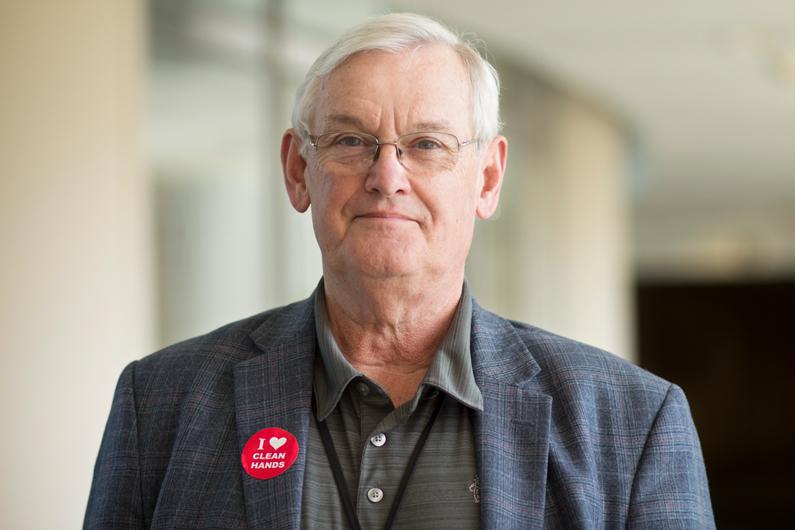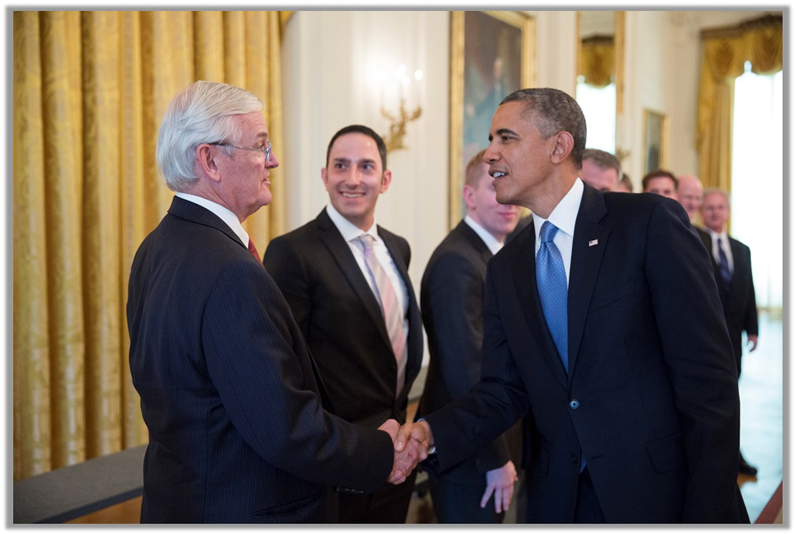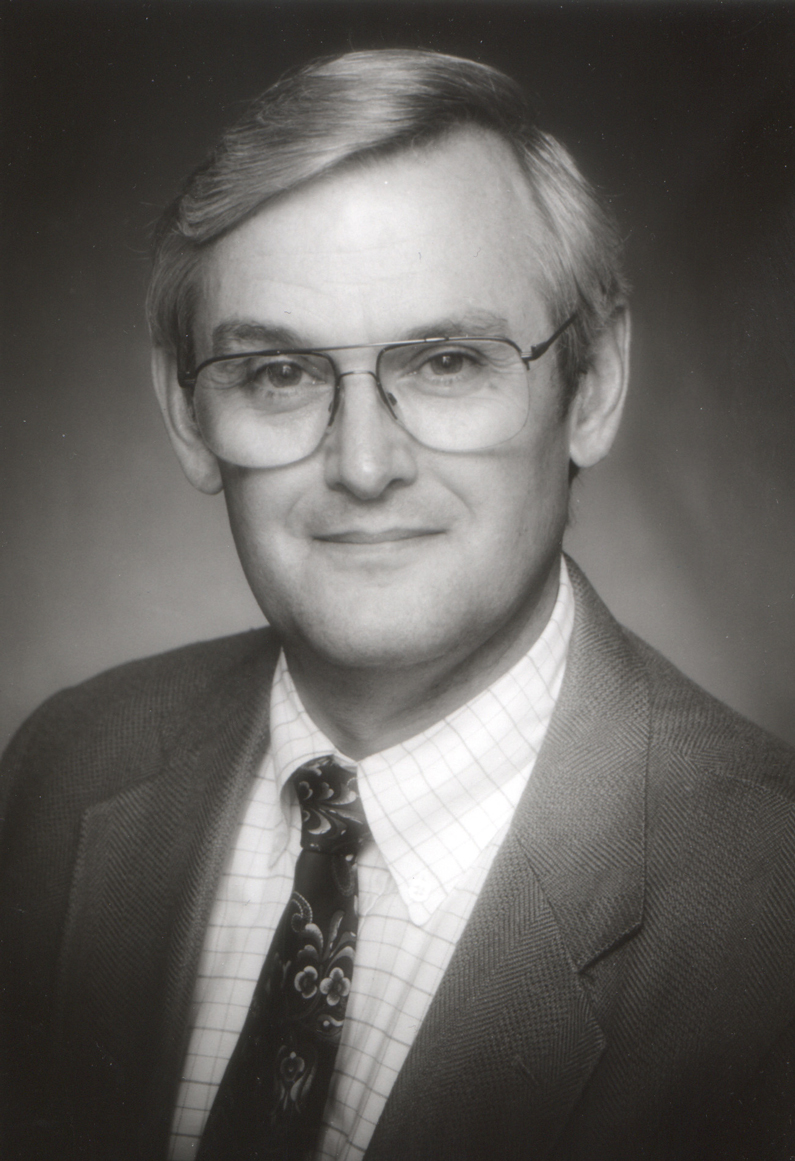David Henderson retires from the Clinical Center after 40 years
First epidemiologist at the hospital helped navigate medical milestones such as HIV, Ebola and antibiotic resistant infections

HIV/AIDS. Antibiotic resistant infections. Ebola virus. Most of us would do everything in our power to avoid these infections, but Dr. David Henderson spent his life planning on how to analyze, treat and keep patients and staff safe from these and many other infectious threats.
Henderson retired at the end of December 2019. He served as the first – and last – Deputy Director for Clinical Care for the NIH Clinical Center, as the person following in his footsteps will assume the new title Chief Medical Officer. Henderson also served as the Associate Director for Hospital Epidemiology and Quality Improvement for the research hospital at the heart of the NIH. He originally came to NIH in 1979 as the Clinical Center's first hospital epidemiologist. A search is underway for Henderson's successor and will be announced in 2020.
Henderson's primary research interests through his career have been understanding and preventing the transmission of blood borne pathogens, such as hepatitis B, hepatitis C, and HIV, in the healthcare setting and the epidemiology and prevention of healthcare-associated transmission of multidrug resistant organisms.
After earning his undergraduate degree from Hanover College in Indiana, and his medical degree from the University of Chicago's Pritzker School of Medicine, Henderson completed an internship and residency in internal medicine and a two-year fellowship in infectious diseases at Harbor-UCLA (University of California at Los Angeles) Medical Center. He was later appointed as an assistant professor of medicine at the UCLA School of Medicine.
An invited speaker internationally, Henderson also is a frequently invited consultant to the Centers for Disease Control and Prevention. He has published more than 163 peer-reviewed journal articles and 78 book chapters so far in his career.
His role in medical organizations focuses on infectious diseases and healthcare epidemiology. He is a member of the Rapid Communications Task Force of the Infectious Diseases Society of America and was selected as the initial Chair of the Society for Healthcare Epidemiology of America (SHEA) Research Committee.
HIV and the Clinical Center

Henderson has been at ground zero from the onset of the AIDS crisis, the rise of antibiotic resistant infections and when the Clinical Center treated four patients who had been infected with or exposed to the Ebola virus.
In an interview with the NIH History Office in 1996, Henderson described navigating the fraught environment of the 1980s and meeting the first patient who had HIV, until then an unidentified disease.
"I remember looking at the first patient at the NIH Clinical Center, not knowing what the patient had. The patient had been admitted to [Dr. Thomas] Tom Waldmann's immunodeficiency service and I went as a consultant and stood around the bed of a man whose name I used to be able to remember. I remember standing around with several of the world's most eminent immunologists looking at this young man," Henderson told the interviewer.
Henderson had complementary motivations: ensuring that patients identified with this new infection received the best treatment available while contributing to the research of this disease and also helping staff navigate the concern and worry that came with treating patients with this new pathogen.
"I knew already, as the hospital epidemiologist…that health care workers are at extraordinary risk for acquiring hepatitis B in the workplace, and I began to develop serious anxieties about the risk our health care workers might be taking by providing care for these patients. No one had any idea what that risk might be at the time. We were beginning to think about that."
Those risks hit home when an accidental exposure to HIV infected samples resulted in a Clinical Center staff member contracting the virus. Henderson took the news hard.
"[I]t was a traumatic event for a hospital. And I still take that seriously, actually. I mean, I think, in retrospect, there were things I hadn't even thought of that we might have done to make the place safer that we've now done, but it cost a life. That's not a trivial issue. And for a while, I used to see her walking around the hall, and that was the constant reminder that you have to keep your guard up."
Ebola in 2014
Echoes of HIV came back for Henderson in 2014 with the outbreak of the Ebola virus in West Africa and subsequent isolated cases in the United States. The NIH has played a leading role in research on potentially lifesaving Ebola vaccines and providing crucial scientific knowledge on the virus's genetic makeup and transmission. The NIH Clinical Center's Special Clinical Studies Unit (SCSU), a 4,000 square foot, four room and seven bed isolation clinic opened in 2010 that has played an important role in that research.

When the outbreak spread, Henderson, along with his colleague Dr. Tara Palmore (appointed the Clinical Center's hospital epidemiologist in 2014) began planning to manage the needs of patients who are in the throes of this blood borne pathogen. Direct contact with body fluids of patients can transmit Ebola, so the hospital had to plan for ways to dispose of up to five liters of fluids a day per patient, while ensuring the safety of the care team.
In addition to the physical preparations, they also had to prepare the hospital community for the arrival of the disease. Palmore posted a 12-page white paper with information about Ebola on NIH's public website and spoke at two town hall meetings for staff in an effort to address concerns.
Said Henderson "…if you do not seek the advice or counsel of the people for whom you are designing these guidelines, you are not very insightful."
The care and training paid off. Four patients exposed to or infected with the Ebola virus were treated and discharged from the NIH Clinical Center, with no adverse impacts for staff and innumerable data points collected for research.
KPC Outbreak and a New way to Assess Infections
It's every doctor's nightmare. Your patient acquires an infection. You work hard to identify it and begin treatment. But your treatment regimen, which is usually successful, isn't working and the patient succumbs to illness. That happened seven times in the summer of 2011 and it was Henderson's job to stop it.
NIH Clinical Center staff first detected carbapenem-resistant Klebsiella pnueumoniae (KPC) in an intensive care unit patient. The bacteria was resistant to almost every form of antibiotic.
Palmore and Henderson worked to limit the spread of the infection and collaborated with two researchers – Drs. Julie Segre and Evan Snitkin – from the National Human Genome Research Institute (NHGRI). The team added state-of-the-art genome sequencing and bacterial DNA analysis to the hospital's rigorous surveillance routines. With the cooperation of colleagues and care-giving staff-the KPC outbreak was brought under control.
The Clinical Center's experience with KPC klebsiella was not unusual – the Centers for Disease Control and Prevent estimate that on any given day, about one in 31 hospital patients has at least one healthcare-associated infection. But the Clinical Center's approach was different than most hospitals: it documented and shared data about its experience.

According to John Buntin, writing in Washingtonian Magazine, he spoke with epidemiologists who suggested "in many other hospitals the patients would simply have died of an unspecified bloodstream infection without anyone ever knowing the precise cause of their illness or how the infection had spread."
This innovative approach culminated in Service to America medals for the doctors for their efforts to trace transmission routes using genomic techniques and infection control that serve as a model for other hospitals facing the problem of antibiotic resistance and transmission of potentially dangerous bacteria in the healthcare setting.
What's Next
Henderson was honored at a retirement gathering Dec. 10. At the event, Dr. James Gilman, Clinical Center CEO said, "He is completely dedicated to the mission of the Clinical Center. He feels passionate about the science we do here and he feels equally passionate about the patients we take care of and their families."
Dr. John Gallin, NIH Associate Director for Clinical Research & Chief Scientific Officer of the NIH Clinical Center, added "David and I were partners in the whole experience, watching all sorts of amazing things happen. What I will remember most: good time with an incredible person who had this incredible knowledge about the Clinical Center…That's what makes this so special."
And Dr. Leighton Chan, chief of the NIH Clinical Center Rehabilitation Medicine Department, stated "David is a people-person – he never really thought of NIH-staffers, he thought of family members at the Clinical Center."
After he retires, Henderson plans to take on his next challenge: serving as President of the Society for Healthcare Epidemiology of America. He will continue to serve in a consulting role at the hospital.
Related Links
In their own words...NIH Researchers Recall the Early Years of AIDS
An oral history interview with Dr. David K. Henderson by the NIH Historical Office
June 13, 1996
Dr. David Henderson Interview
NIH History Office
February 10, 2003
Outbreak at NIH
Washingtonian Magazine
June 4, 2013
Federal Employee Of The Year Honorees Hail From NHGRI And NIH Clinical Center
National Human Genome Research Institute
October 17, 2013
How Bethesda's NIH Prepared for Its First Ebola Patient, Nina Pham
Bethesda Magazine
May 6, 2015
- Donovan Kuehn